Overview
This article delves into best practices for leveraging connection sources in integration projects, underscoring the critical need for selecting suitable connection types to bolster operational efficiency and mitigate risks.
What challenges do you face in your integration efforts? By outlining essential considerations such as compatibility, security, performance, and scalability, we aim to address these issues comprehensively.
Furthermore, the role of Avato’s hybrid connection platform is highlighted as a pivotal solution in facilitating seamless integration. It effectively tackles common obstacles like data silos and incompatibility, ensuring a smoother operational flow.
As a result, embracing these best practices can significantly enhance your integration strategy.
Introduction
In an increasingly interconnected world, the ability to seamlessly integrate diverse systems and applications is paramount for organizations striving to maintain a competitive edge. Connection sources—ranging from legacy systems to modern cloud services—play a crucial role in shaping the architecture of integration projects.
Understanding these sources not only facilitates the flow of data but also mitigates the risks associated with data silos and incompatibility issues. As businesses embark on their digital transformation journeys, the strategic selection and management of connection sources emerge as essential components for success.
This exploration delves into the intricacies of connection sources, offering insights into best practices, common challenges, and the transformative potential of a well-executed integration strategy.
Are your connection sources aligned with your integration goals? Discover how the right approach can redefine your organization’s capabilities.
Understanding Connection Sources: The Backbone of Integration Projects
Connection origins encompass a diverse array of systems, databases, and applications that supply essential information and functionality for incorporation projects. These origins span from legacy systems and cloud services to APIs and databases. Understanding the essence and roles of these connection sources is crucial, as they dictate the transfer of information between systems and significantly influence the structure of the unification solution.
For example, a banking institution often relies on various legacy systems to manage customer information. This reliance necessitates a robust unification strategy to facilitate seamless information access and real-time updates, both of which are vital for maintaining a competitive edge. Recent findings indicate that 38% of organizations identify the unification of isolated applications and information as their most significant challenge in digital transformation initiatives.
This statistic underscores the importance of effectively managing connection source origins to mitigate risks associated with data silos and incompatibilities.
Avato, derived from the Hungarian word for ‘dedication,’ symbolizes a commitment to tackling complex unification challenges. Its dedicated hybrid connection platform guarantees 24/7 uptime for critical links, emphasizing the reliability of the solutions being discussed. By identifying the various connection options available, organizations can strategically plan their unification projects.
Leveraging Avato’s hybrid connection platform empowers businesses to harness the potential of their legacy systems while ensuring seamless integration of new technologies. Successful incorporation projects frequently utilize a blend of legacy systems and APIs, illustrating that a well-considered approach to connection sources can enhance operational capabilities and reduce costs.
Avato’s platform provides real-time monitoring and alerts on system performance, essential for sustaining operational efficiency. Industry leaders emphasize that the design of unified solutions must be adaptable to meet evolving demands. A reliable technology stack not only addresses current operational needs but also equips entities to respond swiftly to future challenges.
As organizations navigate the complexities of unification, the significance of connection source points remains pivotal in driving successful outcomes.
Choosing the Right Connection Sources: Key Considerations for Success
When selecting connection sources for integration projects, organizations must carefully evaluate several key factors to ensure successful outcomes.
- Compatibility is crucial; verifying that the connection origin can integrate seamlessly with existing systems and technologies is essential. This involves confirming supported protocols and formats to prevent compatibility issues, which impact 71% of organizations that require at least three weeks to launch a single integration.
- In sectors such as banking and healthcare, where information sensitivity is paramount, selecting providers that adhere to regulatory standards and offer strong security features is essential. Organizations must prioritize security considerations to protect sensitive information and maintain compliance with industry regulations.
- Performance is another vital consideration. Assessing the performance capabilities of connection sources encompasses their ability to manage diverse data loads and uphold optimal response times, ensuring that connection processes do not impede operational efficiency.
- Scalability is also critical. As businesses evolve, their integration needs will change. Choosing resources that can grow with the entity is essential for long-term success, enabling adaptability to new requirements and technologies.
- Finally, organizations should consider the total cost of ownership, which includes licensing, maintenance, and potential training expenses associated with the connection methods. A thorough cost analysis helps in making financially sound decisions that align with budget constraints.
By carefully assessing these aspects, companies can improve the efficiency of their unification initiatives, ensuring they address both present and future requirements while maximizing the capabilities of their legacy systems. As Gustavo Estrada from BC Provincial Health Services Authority noted, “Avato has simplified complex projects and delivered results within desired time frames and budget constraints,” highlighting the importance of selecting reliable connection sources. Moreover, Avato’s dedication to delivering a dependable, future-ready technology stack, driven by its hybrid connectivity platform and worldwide collaborations, assists entities in adjusting to evolving needs.
This emphasizes the importance of speed, security, and simplicity in system unification, while also tackling the challenges of vendor-provided connection source solutions in connected banking. Avato’s services, including enterprise architecture, project management, and technical analysis, are designed to help entities navigate these challenges effectively. Furthermore, involving stakeholders early and modeling new business processes can further enhance incorporation efforts, ensuring that organizations are well-prepared for future developments.
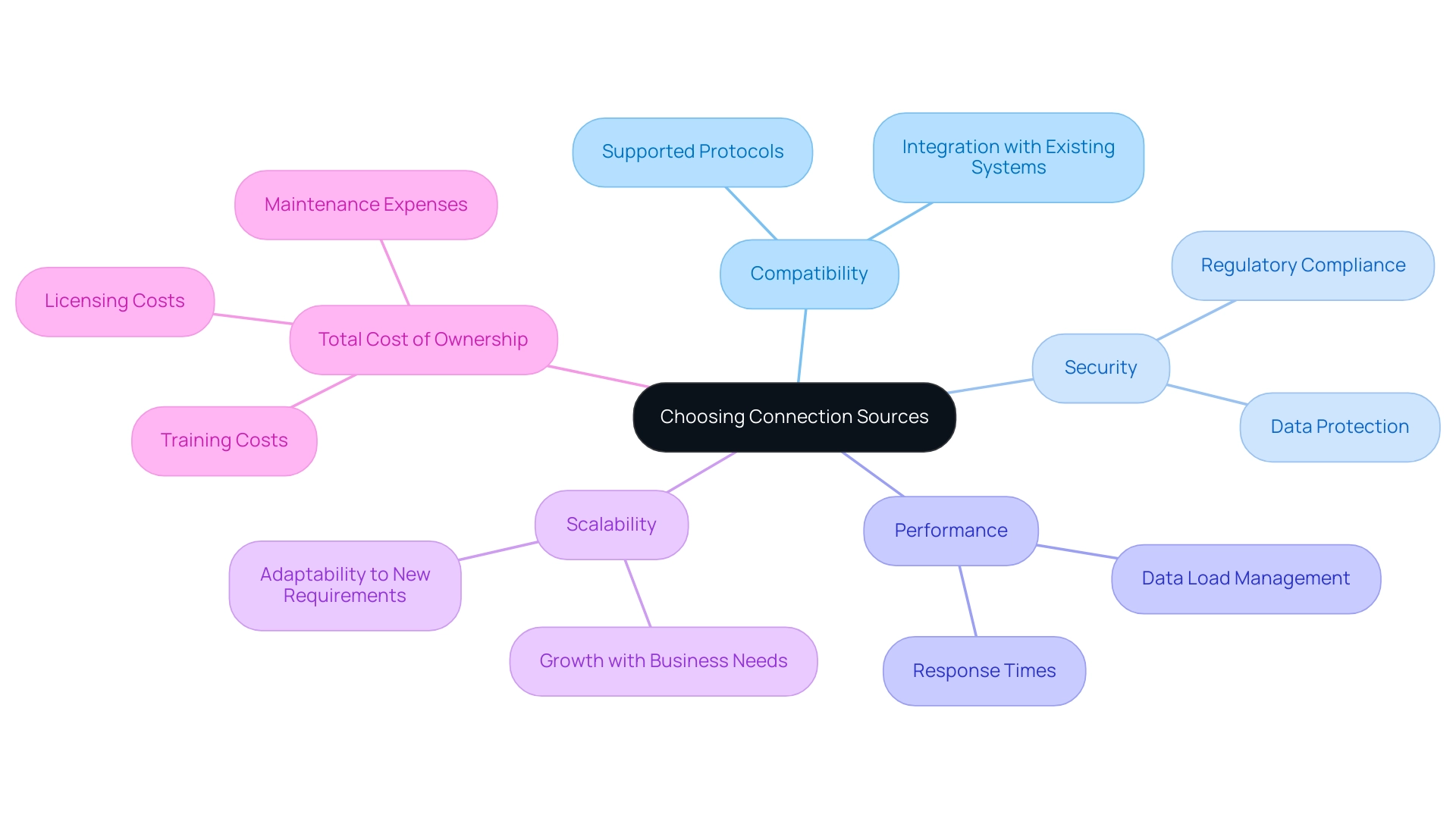
Exploring Different Types of Connection Sources for Effective Integration
Connection sources in integration projects can be categorized into several distinct types, each serving unique purposes that are vital for successful implementation:
- APIs (Application Programming Interfaces): APIs are essential in enabling communication between various software applications, facilitating seamless information exchange and functionality sharing. Their significance has surged in modern integrations, particularly within cloud environments, where they serve as the backbone for connecting diverse services and applications. Notably, 24% of those who use API key vault security tools favor Azure Key Vault, underscoring the importance of security in API management.
- Databases: Both traditional relational databases, such as SQL Server and Oracle, and NoSQL databases like MongoDB, are essential information repositories. Combining these resources enables companies to effectively retrieve and handle large volumes of information, which is essential for informed decision-making and operational effectiveness.
- Cloud Services: The uptake of cloud-based solutions, including AWS and Azure, has become increasingly common among entities for information storage and processing. Integrating these services not only enhances flexibility and scalability but also supports the growing trend of hybrid cloud environments, which are expected to dominate integration strategies in 2025. The necessity of API analytics tools for tracking usage and performance is crucial for optimizing API performance and informing scaling decisions.
- Legacy Systems: Despite their age, legacy systems often hold valuable information that organizations cannot afford to overlook. Creating effective strategies to link these systems is essential for companies looking to modernize their technology stack while maintaining historical information and functionality. Avato’s hybrid merging platform utilizes XSLT for XML information transformation, significantly minimizing programming mistakes and improving the efficiency of connecting legacy systems. This declarative processing of XML information structures simplifies the integration process and ensures that content remains interoperable and usable across various platforms.
- File Systems: Flat files, such as CSV or XML, can also serve as connection points, particularly in batch processing scenarios. Comprehending how to incorporate these files into workflows is vital for thorough data management, ensuring that all data inputs are utilized effectively. The use of schemas in conjunction with XSLT can further streamline this process, providing cost-saving benefits by catching errors early in the development phase.
By examining these different connection types, organizations can strategically improve their merging efforts, selecting the most suitable connection source to satisfy their particular needs. As the landscape of unification continues to evolve, staying informed about current trends in API usage and cloud services will be crucial for maintaining a competitive edge. Furthermore, the growing importance of service discovery tools and API orchestration technologies will play a significant role as microservices adoption increases.
Gustavo Estrada’s perspective that ‘Avato can streamline intricate projects and provide outcomes within expected timelines and financial limitations’ emphasizes the efficacy of utilizing these connection channels in collaborative projects.
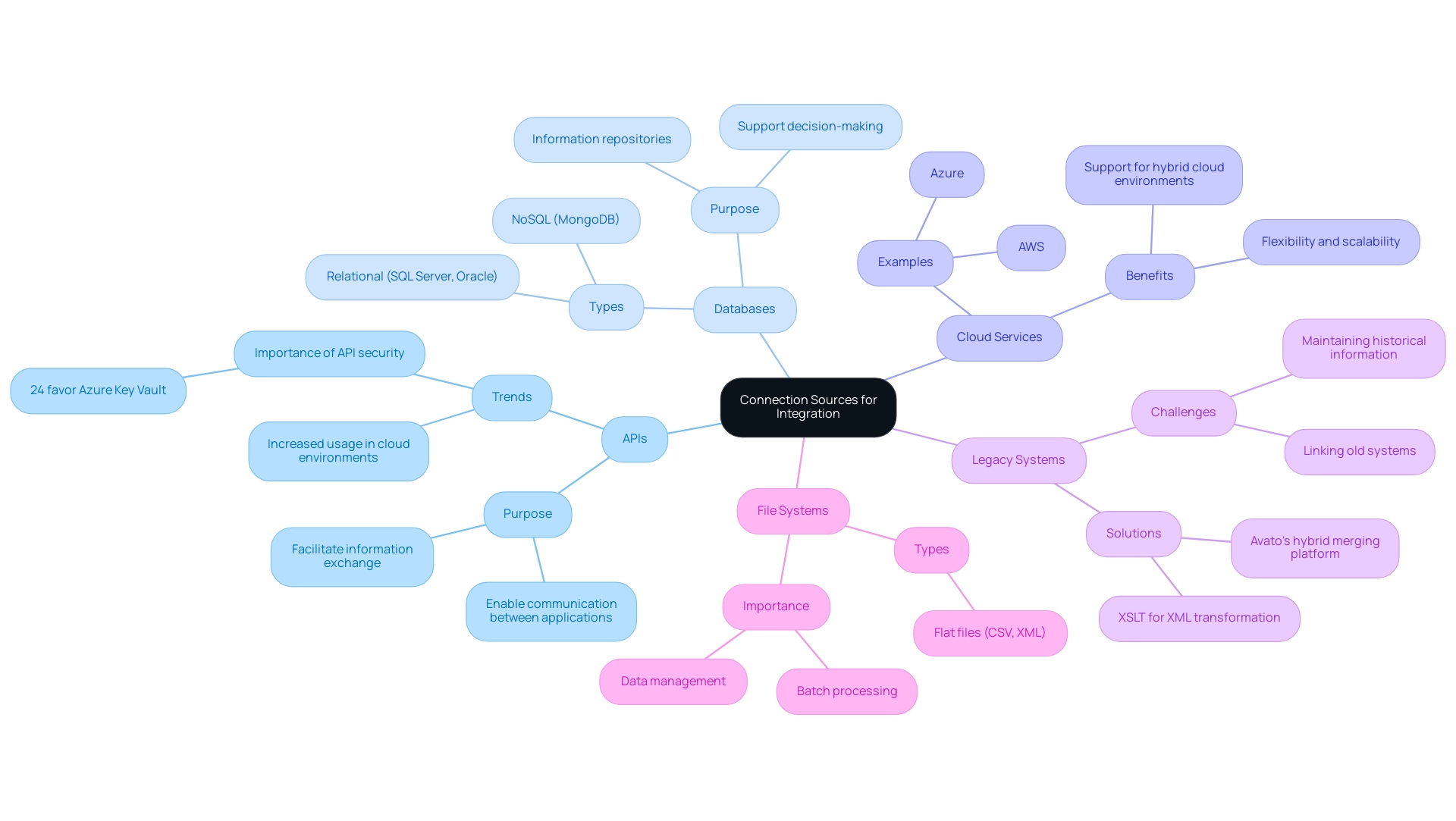
Navigating Challenges: Common Issues with Connection Sources in Integration
Integrating connection sources presents several significant challenges that organizations must navigate to achieve successful integration projects.
- Information Silos: Isolated storage can severely hinder access and integration efforts. Organizations need to implement effective strategies to dismantle these silos, promoting seamless information sharing across systems. Research indicates that entities with data silos experience a 25-35% lower knowledge-sharing index, which can impede adaptive management and strategic agility. Avato’s dedication to ensuring 24/7 uptime for essential connections helps mitigate these issues, allowing organizations to maintain operational continuity. Avato’s hybrid connection platform is designed to unlock isolated assets, enabling businesses to create value by connecting disparate systems efficiently.
- Incompatibility: The variety of connection sources often leads to differing information formats and protocols, complicating assimilation efforts. Standardization is essential to guarantee compatibility, enabling smoother data flow and merging processes. As noted by Gustavo Estrada, Avato simplifies complex projects, enabling organizations to overcome these incompatibility challenges effectively. With support for 12 levels of interface maturity, Avato balances speed of implementation with the sophistication required to future-proof technology stacks.
- Security Risks: The combination of multiple sources inherently increases the potential attack surface for security breaches. It is essential for organizations to adopt robust security measures to safeguard sensitive data during the merging process. Designed for secure transactions, Avato is relied upon by banks, healthcare, and government sectors, ensuring that security is a top priority in all collaborative efforts.
- Performance Bottlenecks: Poorly designed connections can lead to performance issues, including slow response times and increased latency. Ongoing observation and enhancement of connection points are essential for preserving system effectiveness and ensuring that unions do not impede operational performance. Avato’s dedication to delivering a rock-solid foundation for digital transformation initiatives addresses these performance concerns effectively.
- Change Management: As companies develop, their unification needs may alter. Effectively managing these changes is critical to ensure that connection sources remain connected to business needs and continue to support operational goals. Avato’s team of unification specialists is devoted to assisting businesses in navigating these complexities, reinforcing the company’s commitment to simplifying disparate systems and enhancing business value.
The case study titled “Systemic Consequences of Data Silos” highlights how siloed entities can suffer from reduced collective learning and hindered adaptive capacity, emphasizing the importance of addressing these challenges. By identifying and tackling these challenges, entities can formulate focused strategies that reduce interruptions during implementation projects, ultimately improving their operational capabilities and ensuring a more interconnected and efficient data ecosystem. Avato’s DACH region office in Berlin, Germany, offers the expertise required to assist banking IT managers in navigating these complexities, reinforcing Avato’s unique value proposition of delivering speed, security, and simplicity in connectivity.
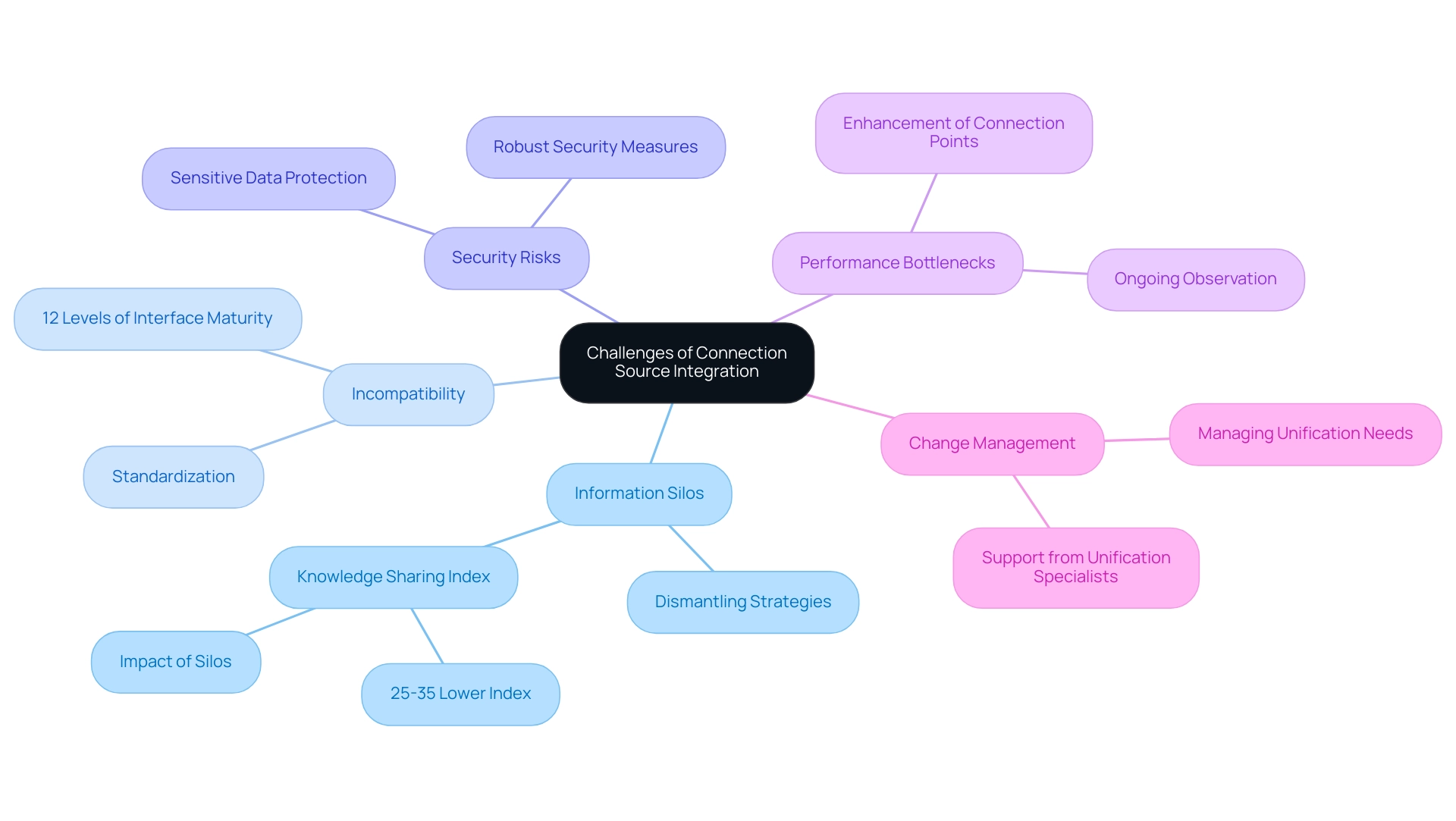
Best Practices for Utilizing Connection Sources in Integration Projects
To effectively utilize connection resources in collaborative projects, organizations must adopt the following best practices:
- Conduct Thorough Assessments: Before launching a connection initiative, it is crucial to evaluate the capabilities and limitations of each connection source. This assessment should encompass performance metrics, security protocols, and compatibility with existing systems. A comprehensive understanding of these factors can significantly mitigate risks associated with incorporation. Recent studies illustrate that thorough assessments lead to more successful incorporation outcomes, akin to the insights gained from the de-escalation intervention plan case study, which underscored the importance of grasping system dynamics.
- Establish Clear Objectives: Clearly defining the goals of the integration project is essential. Each connection point should align with these objectives, ensuring that all stakeholders comprehend how their contributions will facilitate the overall success of the initiative. This clarity not only streamlines decision-making but also enhances accountability throughout the project lifecycle. Statistics reveal that projects with well-defined objectives are more likely to succeed, reinforcing the necessity for clear goals.
- Implement Robust Monitoring: Continuous monitoring of connection sources is vital for the early identification of potential issues. Utilizing real-time notifications and performance dashboards, such as those provided by Avato, enables organizations to track system health, facilitating proactive management of connectivity challenges. This approach is particularly critical in sectors like banking, where system reliability is paramount. As Gustavo Estrada noted, Avato simplifies complex projects and delivers results within desired time frames, emphasizing the significance of effective monitoring.
- Prioritize Information Quality: High-quality information is the backbone of successful merging. Organizations must ensure that information sourced from various connections is accurate, complete, and consistent. Implementing strict validation and cleansing procedures can uphold these standards, ultimately resulting in more dependable assimilation outcomes. Avato’s hybrid unification platform prioritizes data quality, which is crucial for achieving accurate and reliable results in projects, especially when modernizing legacy systems in regulated industries.
- Foster Collaboration: Promoting cooperation between IT teams and business units is essential for aligning projects with organizational needs. This synergy enhances the effective utilization of connection sources, leading to improved project outcomes. Involving stakeholders from various departments ensures that diverse viewpoints are considered, fostering creativity and effectiveness.
By adhering to these best practices, organizations can significantly enhance their collaborative efforts, leveraging Avato’s expert services, including enterprise architecture and project management, to achieve more successful and sustainable results. For further information on how Avato can assist with your merging needs, Contact Us today.
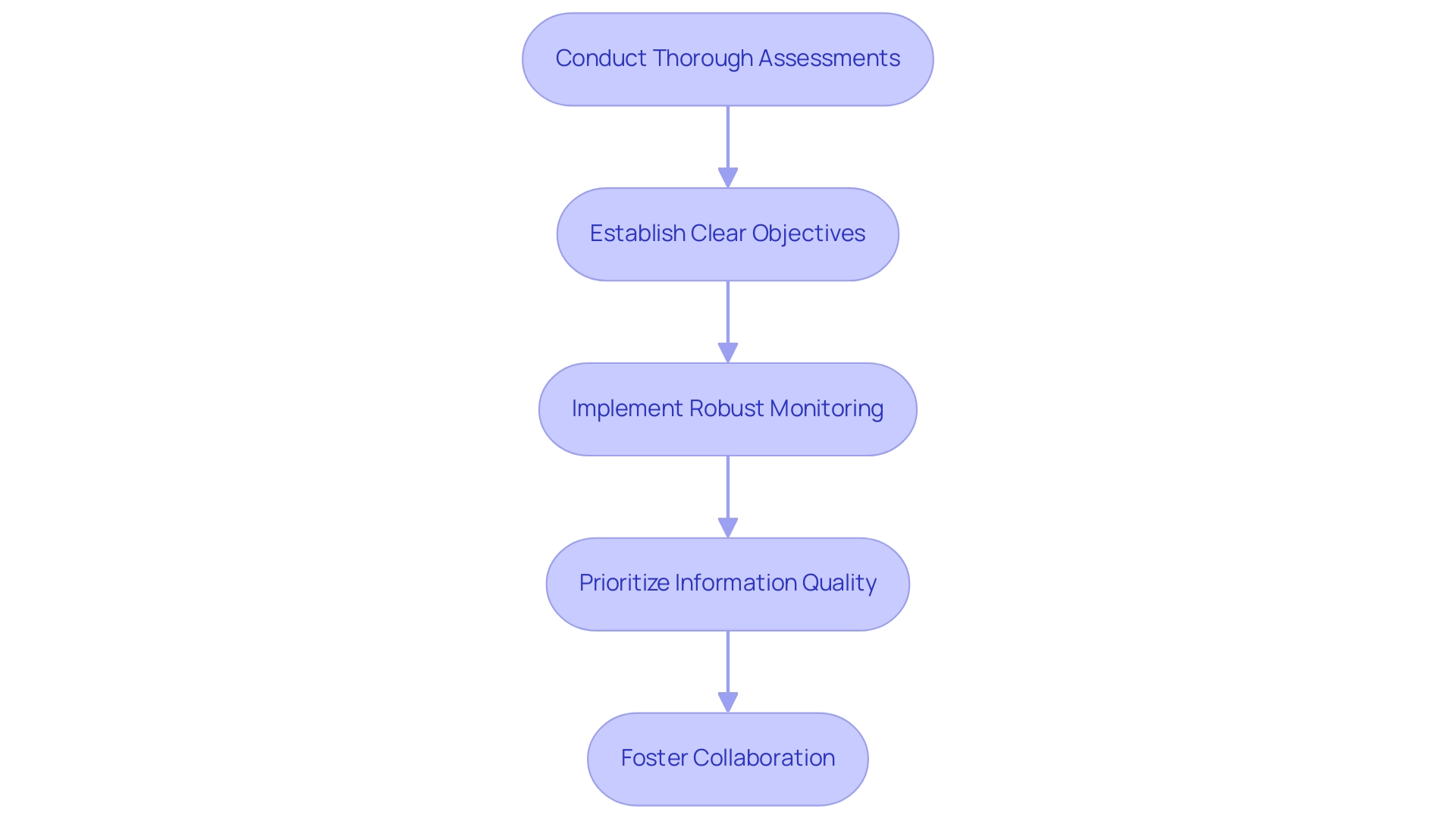
Monitoring and Optimizing Connection Sources: Ensuring Long-Term Success
To guarantee the sustained success of unification projects, organizations must prioritize the monitoring and enhancement of their connection origins. Conducting periodic reviews of the connection source performance is essential for identifying areas that require improvement. This entails examining key metrics such as response times, data throughput, and error rates, significantly affecting overall efficiency. Organizations in the top 1% for employee engagement had nearly five times the success rate of those in the bottom 1%, highlighting the critical role of effective performance management in achieving success. Avato’s robust analytics capabilities enable entities to continuously monitor these metrics, ensuring that performance is optimized over time.
Utilize Automation: Implementing automation tools can streamline monitoring processes and minimize the need for manual intervention. Automated alerts enable teams to respond swiftly to emerging issues, thereby reducing downtime and enhancing system reliability. In 2025, organizations that utilize automation in monitoring are expected to see substantial improvements in operational efficiency. As mentioned in a case study, companies are increasingly utilizing generative AI to simplify the performance review process, assisting in goal setting and performance metric aggregation, which can improve outcomes. Avato’s hybrid connectivity platform supports these automation efforts, allowing for seamless data flow and system unification.
Adapt to Changes: As business needs evolve, adjustments to connection sources may be necessary to remain effective. Organizations should maintain agility in their unification strategies, allowing for modifications that accommodate new requirements or technologies. Effective performance management systems should be agile, allowing for regular feedback and updates to goals, which is crucial for sustaining competitive advantage in a rapidly changing landscape. Avato’s commitment to designing technology frameworks enables businesses to adjust their incorporation strategies effectively.
Invest in Training: Ensuring that team members are well-trained in managing and optimizing the connection source options is vital. Continuous education aids teams in staying informed about best practices and new technologies, promoting a culture of ongoing enhancement that can result in improved results. An understanding of the four basic elements of performance management—goal setting, performance reviews, ongoing development, and rewards—provides a foundation for answering these questions and more, as highlighted by Brooke Weddle. Arvato emphasizes the importance of training as part of its commitment to delivering results for customers.
Document Changes: Keeping detailed records of all modifications made to the connection source and processes is essential. This documentation serves as a valuable resource for troubleshooting and future enhancements, ensuring that knowledge is preserved and accessible. Furthermore, entities must prioritize regulatory adherence and perform security assessments to protect their merging processes, especially in the banking sector. By prioritizing the oversight and enhancement of connection origins, organizations can maintain the effectiveness of their collaborative projects, adapt to changing business environments, and ultimately drive greater success in their digital transformation initiatives.
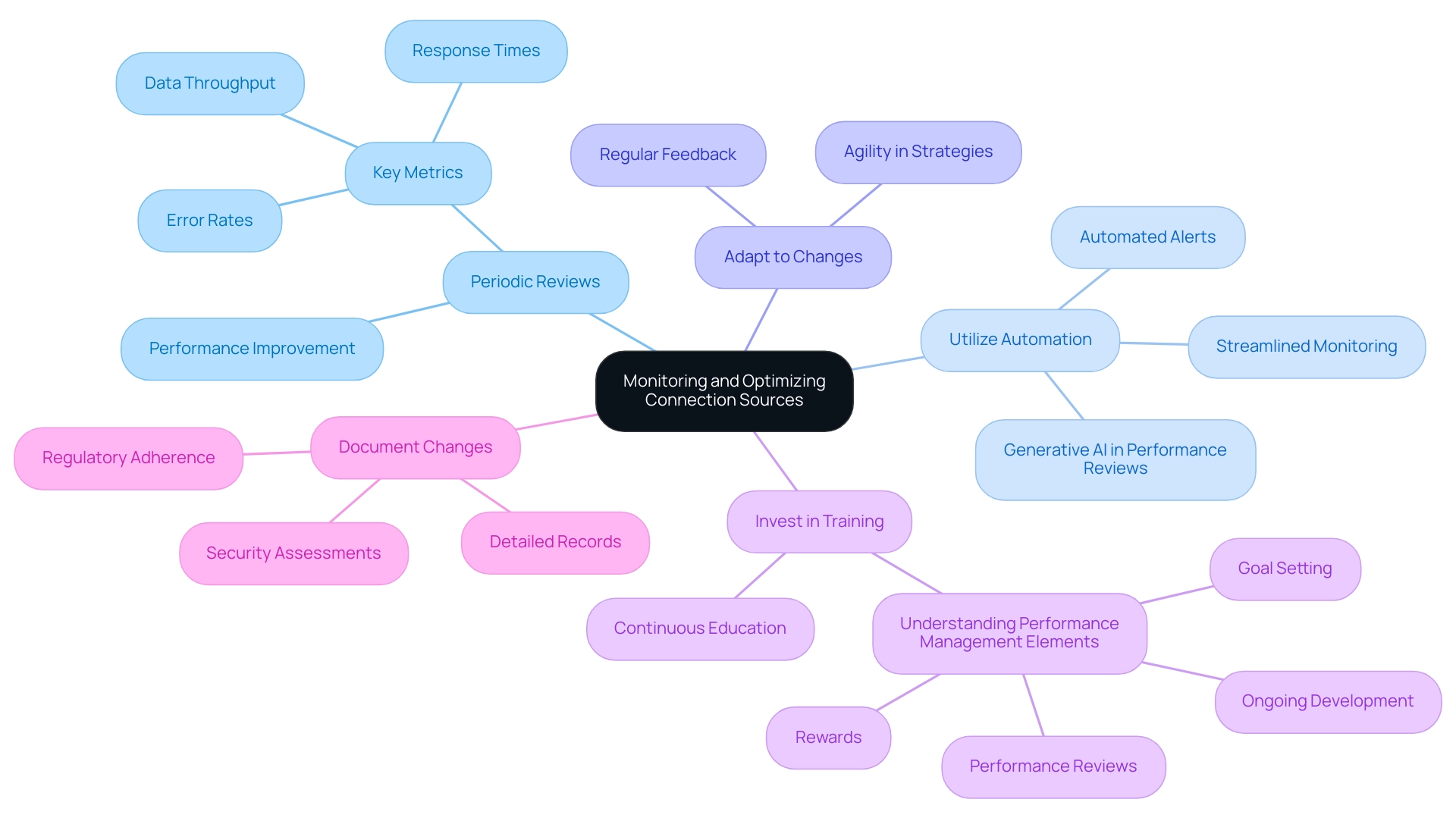
Case Studies: Successful Integration Projects Leveraging Connection Sources
- Banking Integration Project: A prominent bank faced substantial challenges in merging its legacy systems with modern cloud services. By carefully selecting a connection source and executing a comprehensive unification strategy, the bank achieved seamless data flow across its systems. This transformation not only enhanced customer service but also significantly boosted operational efficiency, underscoring the vital role of strategic coordination in the banking sector.
- Avato’s hybrid connection platform, designed for secure transactions and trusted by banks, was instrumental in this success.
- Avato is committed to simplifying disparate systems and elevating business value, which is essential in today’s competitive landscape.
- Notably, 62 percent of publicly traded firms outside of banking achieve similar performance levels, emphasizing the broader significance of successful integration across industries.
- Furthermore, with deposit expenses in the US banking sector projected to reach 2.03% in 2025, efficient unification solutions like those offered by Avato are more critical than ever.
- Avato supports 12 levels of interface maturity, enabling organizations to balance integration speed with the sophistication needed to future-proof their technology stack.
Conclusion
The exploration of connection sources underscores their essential role in the success of integration projects. By grasping the various types of connection sources—spanning APIs, databases, legacy systems, and cloud services—organizations can strategically elevate their integration efforts. The meticulous selection of these sources, weighing factors like compatibility, security, performance, scalability, and cost, is crucial for overcoming prevalent challenges such as data silos and incompatibility issues.
Best practices, including comprehensive assessments, clear objective setting, and a focus on data quality, can drastically enhance integration outcomes. Moreover, continuous monitoring and optimization are vital for sustaining the effectiveness of connection sources in an ever-evolving business landscape. The highlighted case studies reveal that organizations utilizing the right connection sources can achieve seamless data flow, increased operational efficiency, and superior customer service.
Ultimately, the successful integration of diverse systems relies on a well-crafted strategy that prioritizes the management of connection sources. By emphasizing speed, security, and simplicity, organizations can adeptly navigate the complexities of integration and position themselves for future success in their digital transformation journeys. As industries continue to evolve, the necessity of aligning connection sources with integration goals is paramount, marking it as a critical focus for organizations striving to excel in a competitive marketplace.

